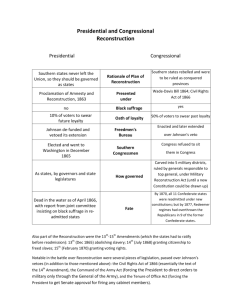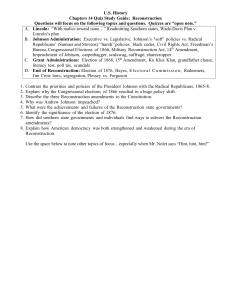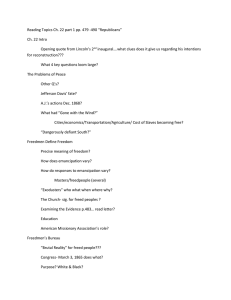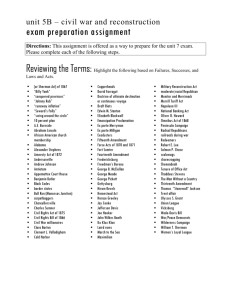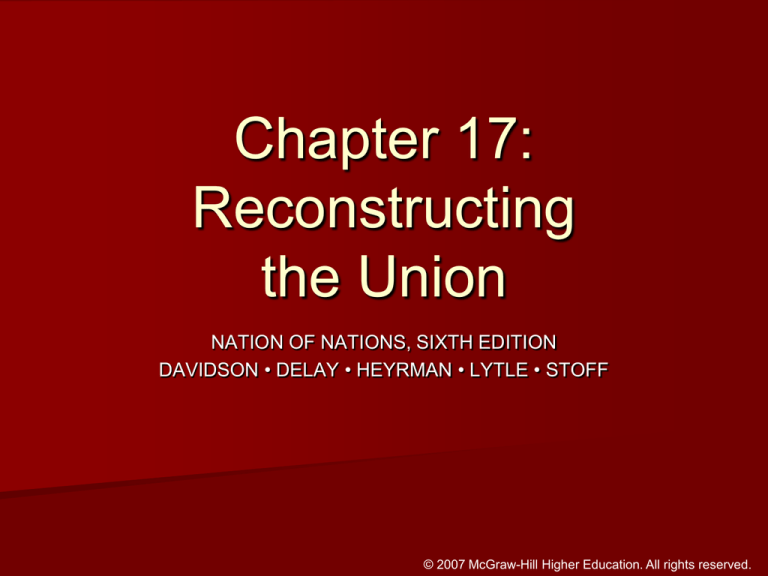
Chapter 17:
Reconstructing
the Union
NATION OF NATIONS, SIXTH EDITION
DAVIDSON • DELAY • HEYRMAN • LYTLE • STOFF
© 2007 McGraw-Hill Higher Education. All rights reserved.
2
Preview
“Reconstruction became the battleground of
attempts to define the new shape of the Union.
Congress rejected Andrew Johnson’s lenient
terms for the South’s reentry and enacted a
program that included the principle of black
suffrage. African Americans asserted their
freedom by uniting divided families, establishing
churches, and seeking education and land.”
© 2007 McGraw-Hill Higher Education. All rights reserved.
3
The Highlights
Presidential Reconstruction
Congressional Reconstruction
Reconstruction in the South
Black Aspirations
The Abandonment of Reconstruction
© 2007 McGraw-Hill Higher Education. All rights reserved.
4
Presidential Reconstruction
Lincoln’s Ten Percent Plan
– Lincoln in 1863: Proclamation of Amnesty and
Reconstruction allowed states to reenter the Union
when 10% of qualified voters took oath of loyalty
– Radical Republicans disagreed with leniency of the
proposal
– Lincoln vetoed Wade-Davis Bill
– President and Congress working out compromise
when he was assassinated
© 2007 McGraw-Hill Higher Education. All rights reserved.
5
The Mood of the South
– Northerners concerned about the attitude of
ex-Confederates
– Lincoln’s death complicated the delicate task of
dealing with Southerners
Johnson’s Program of Reconstruction
– Johnson was a native Southerner, but deeply disliked
the planter class
– Johnson largely followed Lincoln’s plan, at least
initially
© 2007 McGraw-Hill Higher Education. All rights reserved.
6
© 2007 McGraw-Hill Higher Education. All rights reserved.
7
The Failure of Johnson’s Program
– Southern states defied the federal government
– Enactment of Black Codes, heavily restrictive laws
against African Americans
– Elections in the South returned ex-Confederates to
power; Johnson’s resolve began to buckle
Johnson’s Break with Congress
– Issue of black rights drove wedge between president
and Congress
– Johnson’s vetoes aggravated tensions
© 2007 McGraw-Hill Higher Education. All rights reserved.
8
The Fourteenth Amendment
– 1866: amendment passed in Congress
– Broadened citizenship to include African Americans
– Ratified in 1868 in spite of Johnson’s and most
Southern states’ opposition
The Elections of 1866
– Anti-black riots throughout the South, 1866
– Radicals repudiated Johnson
© 2007 McGraw-Hill Higher Education. All rights reserved.
9
Congressional Reconstruction
Post-Emancipation Societies in the Americas
– United States and Haiti (1804) were the only
countries in the Americas where slavery was
destroyed by violence
– United States was unique in that suffrage was
granted almost immediately
– Importance of the vision of Radical Republicans
© 2007 McGraw-Hill Higher Education. All rights reserved.
10
The Land Issue
– Blacks’ desire for land
– Failure of land distribution rested on American belief
in self-reliance
Impeachment
– Tenure of Office Act used by Republicans to impeach
the president
– May 1868: Senate acquitted the president, but only
one vote short of conviction (36-19)
© 2007 McGraw-Hill Higher Education. All rights reserved.
11
© 2007 McGraw-Hill Higher Education. All rights reserved.
The Southern States during
Reconstruction
12
© 2007 McGraw-Hill Higher Education. All rights reserved.
13
Reconstruction in the South
Black Office Holding
– Black men constituted 80% of Republicans in the
South
– Most black office holders were literate and came from
top levels of black society
“Increasingly the success or failure of Reconstruction
hinged on developments not in Congress but in the
southern states themselves. Power there rested with the
new Republican parties, representing a coalition of black
and white southerners and transplanted northerners.”
© 2007 McGraw-Hill Higher Education. All rights reserved.
14
White Republicans in the South
– Black voters were a majority in only three southern
states; Republicans therefore needed white votes
– Such voters were largely yeoman farmers from the
upland districts and “carpetbaggers” (northern
transplants)
– Serious divisions among southern Republicans
© 2007 McGraw-Hill Higher Education. All rights reserved.
15
The New State Governments
– New state constitutions included many political and
social reforms
– All granted political equality but social equality was
generally ignored
Economic Issues and Corruption
– Southern economy in ruins
– Corruption was rampant and state debt was
skyrocketing
© 2007 McGraw-Hill Higher Education. All rights reserved.
16
Black Aspirations
Experiencing Freedom
– Changing employment was a big step for ex-slaves
– Taking last names was a symbolic transition from
slavery to freedom
“Emancipation came to slaves in different ways and
at different times… Whatever the timing, freedom
meant a host of precious blessings to people who
had been in bondage all their lives.”
© 2007 McGraw-Hill Higher Education. All rights reserved.
17
© 2007 McGraw-Hill Higher Education. All rights reserved.
18
The Black Family
– African Americans tried to strengthen their families in
freedom
– Black Americans copied gender roles of white families
The Schoolhouse and the Church
– Black education was a high priority
– Teachers in Freedman’s Bureau schools were
typically young northern women
– Independent black churches became important nodes
of community
© 2007 McGraw-Hill Higher Education. All rights reserved.
19
New Working Conditions
– Blacks asserted control over their work by refusing
the work conditions of slaves
– Sharecropping became the typical arrangement; often
highly exploitative
The Freedman’s Bureau
– Bureau’s record was mixed because of divergent
racial attitudes of its agents
– End of program in 1872 signal of the North’s waning
commitment to Reconstruction
Planters and a New Way of Life
– Planters’ new values focused on economics
© 2007 McGraw-Hill Higher Education. All rights reserved.
20
A Georgia Plantation after the War
© 2007 McGraw-Hill Higher Education. All rights reserved.
21
The Abandonment of
Reconstruction
The Election of Grant
– Gen. Grant elected in 1868
– 1870: Fifteenth Amendment ratified; granted suffrage
to blacks
– Proponents of women’s suffrage disappointed by
amendment’s silence on women’s suffrage
© 2007 McGraw-Hill Higher Education. All rights reserved.
22
The Grant Administration
– Corruption under Grant was rampant
– Reformers began to focus on cleaning up corruption
rather than on blacks’ rights
Growing Northern Disillusionment
– Civil Rights Act of 1875 was the last major piece of
Reconstruction legislation
– Economic depression in 1873 led to Democratic
resurgence and growing disinterest in issues of
Reconstruction
© 2007 McGraw-Hill Higher Education. All rights reserved.
23
The Triumph of White Supremacy
– Racism not dissipated by Reconstruction
– Rise of the Ku Klux Klan led to federal attempts to
stem racial violence
– Mississippi Plan—bold effort by the Democrats to use
force to win the election
The Disputed Election of 1876
– Election between Hayes and Tilden unresolved
because of votes in last three unreconstructed states
– Compromise of 1877 made Hayes president
© 2007 McGraw-Hill Higher Education. All rights reserved.
24
Racism and the Failure of Reconstruction
– Reconstruction failed for many reasons, racism chief
among them
– End of the Davis Bend experiment, 1875
“By 1877, the entire South was in the hands of the
Redeemers, as they called themselves. Reconstruction
and Republican rule had come to an end.”
© 2007 McGraw-Hill Higher Education. All rights reserved.


